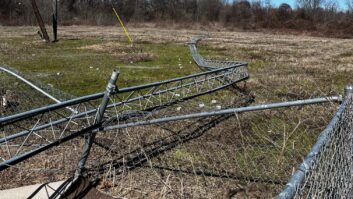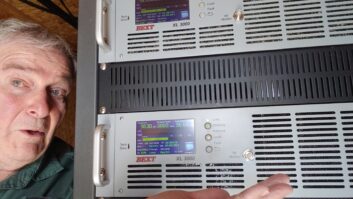
Fig. 1: A warm transmitter is a real temptation. Send us suggested captions for this photo and we’ll publish the best ones.
John George and Fayne Anderson handle equipment sales and do contract and project work out of Columbia, S.C. Recently they made a trip to a small-market AM station to repair a transmitter that was DOA. They found the culprit, seen in Fig. 1.
Even in warmer climates such as we might find in South Carolina, mice and insects love a warm transmitter during winter months. Seal your transmitter building; it’s less costly than being off the air because of a failed power supply.
Thanks, guys, for the winterizing reminders and the great photo (is that a vole?). John George of Broadtech Services can be reached at [email protected].
So, let’s have a caption for this shot! E-mail your suggestions to [email protected]. And remember to use the camera on your smart phone to document any damage for your client — or to submit to Workbench.
* * *
With so many USB audio interfaces having embedded themselves in Chuck Bullett’s Cumulus San Francisco operations, he’s wound up with a pile of old Henry analog –10 dB unbalanced to +4 dB balanced bidirectional Matchbox audio converters on his “to be forgotten” shelf.
Gone are the cassette decks, cheap computer audio cards and other consumer audio devices in his plant. And now that USB interfaces are so popular, combined with flash drive and audio capture devices, the old-style Matchbox has been all but displaced by Henry’s popular USB interfaces.
The first-gen Matchboxes found a new home, however, at Chuck’s transmitter sites. He’s using them ahead of Arbitron’s PPM QoS monitor decoders as a gain stage. The analog PPM decoders require a consistent +4 dB to saturate the audio inputs. Chuck’s Inovonics off-air QoS receivers, though balanced at their output connectors, only provide –10 dB. Chuck wires the high (+) lead for each channel to the tip of the RCA connector going to the Matchbox’s input, and connects the low/ground (–) and shield to the ring of the RCA input on the Matchbox. The Matchbox provides sufficient gain to saturate the PPM monitor’s inputs for healthy watermark sampling.
If the PPM decoders do not see enough audio to sample, they’ll alarm and cry out for help. One thing that makes Chuck’s heart stop these days is seeing the red alarm light flashing on those QoS monitors; in his view that situation requires an immediate response. Chances are you’re still encoding; but without substantial audio driving the input on the QoS monitor, one can’t be sure. In the markets that are using Arbitron’s PPM for currency, when the red light goes out you might as well be off the air, at least as far as ratings go.
The key for controlling Chuck’s blood pressure is in feeding the PPM monitor a robust audio signal. Repurposing the Matchbox has solved the problem.
* * *

Fig. 2: Be sure to check the date function on your EAS equipment. It should go without saying that attention to your EAS tests is a paramount engineering duty.
Fig. 2 shows a funny time stamp on a Sage EAS unit. The contributor, who wishes to remain anonymous, writes that the date stamp year probably explains why the RMT did not go through.
* * *
Standard duct tape can take a back seat now that Gorilla Tape has arrived.
Typical duct tape adheres best to smooth surfaces. Gorilla Tape, with its additional adhesive, will stick to uneven surfaces. This makes it ideal for remote kits. I’ll grant that this brand of waterproof tape is more difficult to pull off the roll because it has more adhesive than duct tape; but it tears sideways with minimal effort.

Fig. 3: Gorilla Tape, with its additional adhesive, is ideal for remote kits. Its “Tough and Wide” roll, 3 inches across, will secure microphone, speaker or AC cables to concrete, brick or tile. Reduce your liability at a remote by securing cables across thresholds or in a parking lot.
I recently needed to cap an open conduit and didn’t have a PVC or other cap handy, so I tried the tape. Having never used the tape, I plugged the conduit first with a wire wrapped around some paper towels. My thinking was if the tape cap leaked, the towels would absorb the moisture. If the tape really leaked and saturated the paper towel, the wire would help me remove it in one piece, without the paper tearing and fouling the conduit.
I needn’t have worried. When it came time to remove the tape, everything was dry, despite a couple weeks’ worth of heavy wind and rain in the meantime. The tape removed easily and there was none of the residue you would expect with duct tape. Impressive.
For the fun of it I took a small piece of the paper towel and rolled it into a ball, covering it with a couple of pieces of Gorilla Tape fastened to a painted plank; then I left the plank exposed to the sun. After two weeks, the tape pulled up easily, again with no residue. The paper towel was dry.
The Gorilla Tape backing is resistant to UV and water. With these features, the 1-inch size might take the place of black wire ties used to secure outside cables. Send me pictures if you try the tape and find it successful for this application.
The Gorilla guys also offer Gorilla Epoxy. Advertised as setting within 5 minutes, its bond is stronger and will work on steel, aluminum, wood and ceramic. An easy-to-mix syringe applies the appropriate amounts to your project; a tight-fitting cap means the syringe can be reused.
Gorilla products can be found at True Value and Lowes stores. For fun YouTube videos and more information on the company’s products, click on www.gorillatough.com.
* * *
Tom Franklin works for Northwest Communications Systems, headquartered in Oregon. He writes that there’s nothing worse — or more dangerous — than trudging through the snow to get to a site, only to spend the rest of the day, and possibly the night, in cold, wet clothes.
In his years of working on remote mountaintop sites, Tom always carried one or two “space blankets” — aluminized Mylar, as at www.mcrmedical.com — and a large zip-type bag containing a spare, dry stocking cap; gloves or mittens; and a pair of socks.
Use a gallon-size bag and squeeze out the air before sealing; it won’t take up very much room in the winter “crash bag.” Nowadays, a handheld GPS is handy, too. Heavy fog or blowing snow can make it easy to become disoriented.
Great tips, Tom, to keep us safe. I haven’t priced those space blankets in years. You’ll find them at the site listed for only a few dollars, well within the reach of every budget.
Remember to send in your captions for Fig. 1, to [email protected].
John Bisset marked his 40th year in radio in broadcasting recently. He works for Tieline Technology and is a past recipient of the SBE’s Educator of the Year Award. Reach him at [email protected] or (603) 472-5282. Faxed submissions can be sent to (603) 472-4944.
Submissions for this column are encouraged and qualify for SBE recertification credit.












